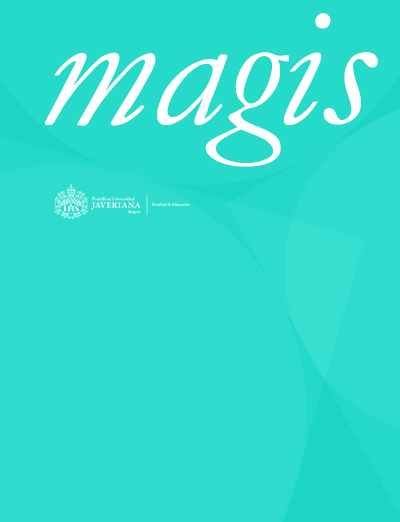Abstract
This article describes how frequently the pedagogy students carry out reflective practices. It also analyze the factors that can explain the frequency. To do so, a quantitative perspective was used including a survey applied to sample of 650 students from 134 teacher training programs in Chile. The results indicate that the most important factors to explain the reflective practice are related to the supervisor. The factors related to the classmates and to the discussion on the teacher career have a lower contribution to the reflective practice.
Bates, A. J.; Ramírez, L. & Drits, D. (2009). Connecting University Supervision and Critical Reflection: Mentoring and Modeling. The Teacher Educator, 44 (2), 90-112. doi: 10.1080/08878730902751993
Beauchamp, C. (2014). Reflection in Teacher Education: Issues Emerging from a Review of Current Literature. Reflective Practice, 16 (1), 123- 141. doi: 10.1080/14623943.2014.982525
Collin, S.; Karsenti, T. & Komis, V. (2012). Reflective Practice in Initial Teacher Training: Critiques and Perspectives. Reflective Practice, 14 (1), 104-117. doi: 10.1080/14623943.2012.732935. Disponible en: http:// www.karsenti.ca/archives/CollinKarsentiKomis2013.pdf
Darling-Hammond, L. & Lieberman, A. (2012). Teacher Education around the World. What Can We Learn from International Practice? En L. Darling-Hammond & A. Lieberman (eds.). Teacher Education Around the World: Changing Policies and Practices, 151-169. New York: Routledge.
Gelfuso, A. & Dennis, D. V. (2014). Getting Reflection Off the Page: The Challenges of Developing Support Structures for Pre-Service Teacher Reflection. Teaching and Teacher Education, 38, 1-11. doi: http://dx.doi.org/10.1016/j.tate.2013.10.012. Disponible en: https://s3.amazonaws.com/arena-attachments/272964/edd6eab9dd18ee89bc6b8b913fb9818d.pdf
Harford, J. & MacRuairc, G. (2008). Engaging Student Teachers in Meaningful Reflective Practice. Teaching and Teacher Education, 24 (7), 1884-1892. Disponible en: http://eprints.teachingandlearning.ie/2428/1/Harford%20and%20MacRuairc%202008.pdf
Ingvarson, L.; Schwille, J.; Tatto, M. T.; Rowley, G.; Peck, R. & Senk, S. L. (2013). An Analysis of Teacher Education Context, Structure, and Quality-Assurance Arrangements in TEDS-M Countries. New Zealand: International Association for the Evaluation of Educational Achievement, IEA. Disponible en: https://www.iea.nl/fileadmin/user_upload/Publications/Electronic_versions/TEDS-M_Findings.pdf
Jaeger, E. (2013). Teacher Reflection: Supports, Barriers, and Results. Issues in Teacher Education, 22 (1), 89-104. Disponible en: https://files.eric.ed.gov/fulltext/EJ1014037.pdf
Jones, M. & Ryan, J. (2014). Learning in the Practicum: Engaging Pre-Service Teachers in Reflective Practice in the Online Space. Asia-Pacific Journal of Teacher Education, 42 (2), 132-146. doi: 10.1080/1359866x.2014.892058
Kember, D.; Leung, D. Y. P.; Jones, A.; Loke, A. Y.; McKay, J., Sinclair, K.; Tse, H.; Webb, C.; Yuet Wong, F. K.; Wong, M. & Yeung, E. (2000). Development of a Questionnaire to Measure the Level of Reflective Thinking. Assessment & Evaluation in Higher Education, 25 (4), 381- 395. doi: 10.1080/026029300449272
Larrivee, B. (2008). Development of a Tool to Assess Teachers’ Level of Reflective Practice. Reflective Practice: International and Multidiscipli- nary Perspectives, 9 (3), 341-360. https://doi.org/10.1080/14623940802207451
Leijen, Ä.; Valtna, K.; Leijen, D. A. J. & Pedaste, M. (2012). How to Determine the Quality of Students’ Reflections? Studies in Higher Education, 37 (2), 203-217. doi: 10.1080/03075079.2010.504814
Mansvelder-Longayroux, D. D.; Beijaard, D. & Verloop, N. (2007). The Portfolio as a Tool for Stimulating Reflection by Student Teachers. Teaching and Teacher Education, 23 (1), 47-62. doi: http://dx.doi.org/10.1016/j.tate.2006.04.033. Disponible en: http://depts.washington.edu/comgrnd/ccli/papers/Mansvelder-Longayroux_etal_PortfolioAsToolStimulatingReflectionByStudentTeachers-jy.pdf
Meckes, L. (2014). Estándares y formación docente inicial. En UNESCO/ OREALC (ed.). Temas críticos para formular nuevas políticas docentes en América Latina y el Caribe: el debate actual, 53-110. Santiago de Chile: UNESCO/OREALC.
Moore-Russo, D. A. & Wilsey, J. N. (2014). Delving into the Meaning of Productive Reflection: A Study of Future Teachers’ Reflections on Representations of Teaching. Teaching and Teacher Education, 37 (1), 76-90. DOI: 10.1016/j.tate.2013.10.002
Podsakoff, P.; MacKenzie, S. & Podsakoff, N. (2012). Sources of Method Bias in Social Science Research and Recommendations on How to Control it. Annual Review of Psychology, 63, 539-569. Disponible en: https://www.annualreviews.org/doi/abs/10.1146/annurev-psych-120710-100452
Salinas, A.; Chandía, E. & Rojas, D. (2017). Validación de un instrumento cuantitativo para medir la práctica reflexiva de docentes en formación. Revista Estudios Pedagógicos, XLIII (1), 289-309. Disponible en: https://scielo.conicyt.cl/pdf/estped/v43n1/art17.pdf
Schön, D. A. (1983). The Reflective Practitioner: How Professionals Think In Action. London, New York: Basic Books.
Sobral, D. T. (2001). Medical Students’ Reflection in Learning in Relation to Approaches to Study and Academic Achievement. Medical Teacher, 23 (5), 508-513. DOI: 10.1080/01421590120042973
Solís, M. C.; Núñez, C.; Contreras, I.; Rittershaussen, S.; Montecinos, C. & Walker, H. (2011). Condiciones de la formación práctica de los futuros profesores. Estudios Pedagógicos (Valdivia), 37, 127-147. Disponible en: https://scielo.conicyt.cl/pdf/estped/v37n1/art07.pdf
Sparks-Langer, G. M.; Simmons, J. M.; Pasch, M.; Colton, A. & Starko, A. (1990). Reflective Pedagogical Thinking: How Can We Promote It and Measure It? Journal of Teacher Education, 41 (5), 23-32. doi: 10.1177/002248719004100504
Magis, International Journal of Research in Education by Pontificia Universidad Javeriana is registered under a Creative Commons Attribution 4.0 International Public License. Thus, this work may be reproduced, distributed, and publicly shared in digital format, as long as the names of the authors and Pontificia Universidad Javeriana are acknowledged. Others are allowed to quote, adapt, transform, auto-archive, republish, and create based on this material, for any purpose (even commercial ones), provided the authorship is duly acknowledged, a link to the original work is provided, and it is specified if changes have behttps://creativecommons.org/licenses/by/4.0/en made. Pontificia Universidad Javeriana does not hold the rights of published works and the authors are solely responsible for the contents of their works; they keep the moral, intellectual, privacy, and publicity rights.
Approving the intervention of the work (review, copy-editing, translation, layout) and the following outreach, are granted through an use license and not through an assignment of rights. This means the journal and Pontificia Universidad Javeriana cannot be held responsible for any ethical malpractice by the authors. As a consequence of the protection granted by the use license, the journal is not required to publish recantations or modify information already published, unless the errata stems from the editorial management process. Publishing contents in this journal does not generate royalties for contributors.
Creative Commons Attribution 4.0 International Public License



